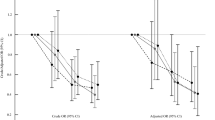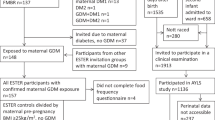Abstract
Background/objectives
Women with premenstrual syndrome (PMS) are encouraged to reduce sugar and increase fiber intake to reduce symptoms. However, research supporting these recommendations is limited, and their role in PMS development is unclear. This study examines the relation between carbohydrate and fiber intake and the risk of PMS nested within the prospective Nurses’ Health Study II cohort.
Subjects/methods
Carbohydrate and fiber intake were assessed at baseline and three additional times during follow up by food frequency questionnaire. Incident cases of PMS were identified by self-reported PMS diagnosis during 14 years of follow up and validated by supplemental questionnaire (n = 1234). Women were classified as controls if they did not report PMS diagnosis during follow up and confirmed minimal or no premenstrual symptoms (n = 2426). We estimated relative risks (RR) and 95% confidence intervals (CI) using multivariable logistic regression.
Results
Total carbohydrate intake 2–4 years before reference year was not associated with PMS development (RR quintile 5 versus 1 = 0.99; 95% CI = 0.74–1.33). Intakes of specific carbohydrates or fibers were not associated with PMS development, except maltose. Adjusting for body mass index, smoking, and other factors, women with the highest maltose intake (median = 3.0 g/day) had a RR of 1.45 (95% CI = 1.11–1.88) compared to those with the lowest intake (median = 1.2 g/day).
Conclusions
Overall, carbohydrate and fiber consumption was not associated with risk of PMS. As this is the first study to suggest that maltose may be associated with PMS development, further replication is needed.
This is a preview of subscription content, access via your institution
Access options
Subscribe to this journal
Receive 12 print issues and online access
$259.00 per year
only $21.58 per issue
Buy this article
- Purchase on Springer Link
- Instant access to full article PDF
Prices may be subject to local taxes which are calculated during checkout
Similar content being viewed by others
References
Halbreich U, Borenstein J, Pearlstein T, Kahn LS. The prevalence, impairment, impact, and burden of premenstrual dysphoric disorder (PMS/PMDD). Psychoneuroendocrinology. 2003;28:1–23.
Johnson SR. The epidemiology and social impact of premenstrual symptoms. Clin Obstet Gynecol. 2006;30:367–76.
Matsumoto T, Asakura H, Hayashi T. Biopsychosocial aspects of premenstrual syndrome and premenstrual dysphoric disorder. Gynecol Endocrinol. 2013;29:67–73.
American College of Obstetricians and Gynecologists. Frequently asked questions FAQ057 gynecologic problems, premenstrual syndrome. 2011. Available at: https://www.acog.org/~media/For%20Patients/faq057.pdf
Association of Reproductive Health Professionals. A quick reference guide for clinicians: managing premenstrual symptoms. 2008. Available at: http://www.arhp.org/uploadDocs/QRGPMS.pdf
Houghton SC, Bertone-Johnson ER. Macronutrients and Premenstrual Syndrome. In: Berhardt LV (ed.) Advances in Medicine and Biology, Vol. 87, pp. 137–56. Hauppauge, NY: NOVA Science Publishers, Inc.; 2015.
Nagata C, Hirokawa K, Shimizu N, Shimizu H. Soy, fat and other dietary factors in relation to premenstrual symptoms in Japanese women. BJOG. 2004;111:594–9.
Johnson WG, Carr-Nangle RE, Bergeron KC. Macronutrient intake, eating habits, and exercise as moderators of menstrual distress in healthy women. Psychosom Med. 1995;57:324–30.
Rasheed P, Al-Sowielem LS. Prevalence and predictors of premenstrual syndrome among college-aged women in Saudi Arabia. Ann Saudi Med. 2003;23:381–7.
Bertone-Johnson ER, Hankinson SE, Bendich A, Johnson SR, Willett WC, Manson JE. Calcium and vitamin D intake and risk of incident premenstrual syndrome. Arch Intern Med. 2005;165:1246–52.
Bertone-Johnson ER, Hankinson SE, Johnson SR, Manson JE. A simple method of assessing premenstrual syndrome in large prospective studies. J Reprod Med. 2007;52:779–86.
Mortola JF, Girton L, Beck L, Yen SS. Diagnosis of premenstrual syndrome by a simple, prospective, and reliable instrument: The calendar of premenstrual experiences. Obstet Gynecol. 1990;76:302–7.
Willett WC. Nutritional Epidemiology. 3rd ed. New York: Oxford University Press; 2012.
Barclay AW, Flood VM, Brand-Miller JC, Mitchell P. Validity of carbohydrate, glycaemic index and glycaemic load data obtained using a semi-quantitative food-frequency questionnaire. Public Health Nutr. 2008;11:573–80.
Bertone-Johnson ER, Whitcomb BW, Missmer SA, Manson JE, Hankinson SE, Rich-Edwards JW. Early life emotional, physical, and sexual abuse and the development of premenstrual syndrome: a longitudinal study. J Womens Health (Larchmt). 2014;23:729–39.
Murakami K, Sasaki S, Takahashi Y, Uenishi K, Watanabe T, Kohri T, et al. Dietary glycemic index is associated with decreased premenstrual symptoms in young Japanese women. Nutrition. 2008;24:554–61.
Cross GB, Marley J, Miles H, Willson K. Changes in nutrient intake during the menstrual cycle of overweight women with premenstrual syndrome. Br J Nutr. 2001;85:475–82.
Gold EB, Bair Y, Block G, Greendale GA, Harlow SD, Johnson S, et al. Diet and lifestyle factors associated with premenstrual symptoms in a racially diverse community sample: Study of Women’s Health Across the Nation (SWAN). J Womens Health (Larchmt). 2007;16:641–56.
Rossignol AM, Bonnlander H. Prevalence and severity of the premenstrual syndrome. Effects of foods and beverages that are sweet or high in sugar content. J Reprod Med. 1991;36:131–6.
Bertone-Johnson ER, Hankinson SE, Johnson SR, Manson JE. Timing of alcohol use and the incidence of premenstrual syndrome and probable premenstrual dysphoric disorder. J Womens Health (Larchmt). 2009;18:1945–53.
Acknowledgements
This work was supported by Public Health Services grants CA176726 and MH076274 from the National Institutes of Health, Department of Health and Human Services; a cy pres distribution from Rexall/Cellasene settlement litigation; and a grant from GlaxoSmithKline Consumer Healthcare.
Author contributions
J.E.M., S.E.H., and E.R.B.-J. designed the research; S.C.H. and E.R.B.-J. conducted the research; J.E.M. and S.E.H. provided essential materials; S.C.H. and E.R.B.-J. performed the statistical analysis; S.C.H. and E.R.B.-J. wrote the paper; B.W.W., L.M.T., and C.B. interpreted study results, reviewed manuscript for important intellectual content, and contributed knowledge of underlying biologic mechanisms; S.C.H., J.E.M., and E.R.B.-J. had primary responsibility for the final content. All authors read and approved the final manuscript.
Author information
Authors and Affiliations
Corresponding author
Ethics declarations
Conflict of interest
The authors declare that they have no conflict of interest.
Electronic supplementary material
Rights and permissions
About this article
Cite this article
Houghton, S.C., Manson, J.E., Whitcomb, B.W. et al. Carbohydrate and fiber intake and the risk of premenstrual syndrome. Eur J Clin Nutr 72, 861–870 (2018). https://doi.org/10.1038/s41430-017-0076-8
Received:
Revised:
Accepted:
Published:
Issue Date:
DOI: https://doi.org/10.1038/s41430-017-0076-8
This article is cited by
-
Do dietary habits affect the premenstrual syndrome severity among a cohort of Egyptian females? A cross-sectional study
Bulletin of Faculty of Physical Therapy (2023)
-
Estimated dietary intake of essential elements from four selected staple foods in Najran City, Saudi Arabia
BMC Chemistry (2019)



